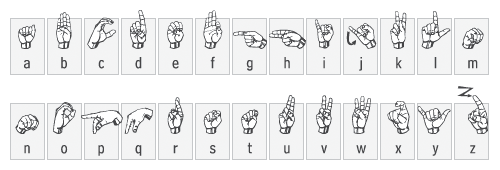American Sign Language and Braille

Sign language for the deaf was first systematized in France during the 18th century by Abbot Charles-Michel l'Epée. French Sign Language (FSL) was brought to the United States in 1816 by Thomas Gallaudet, founder of the American School for the Deaf in Hartford, Conn. He developed American Sign Language (ASL), a language of gestures and hand symbols that express words and concepts.
In many respects, sign language is just like any spoken language, with a rich vocabulary and a highly organized, rule-governed grammar. But in sign language, information is processed through the eyes rather than the ears. Thus, facial expression and body movement play an important part in conveying information.
In spoken language, the relationship between most words and the objects and concepts they represent is arbitrary—there is nothing about the word “tree” that actually suggests a tree, either in the way it is spelled or pronounced. In the same way, in sign language most signs do not suggest, or imitate, the thing or idea they represent, and must be learned. Sign language may be acquired naturally as a child's first language, or it may be learned through study and practice.
Sign language shares other similarities with spoken languages. Like any living language, ASL grows and changes over time to accommodate native users' needs. ASL also has regional varieties, equivalent to spoken accents, with different signs being used in different parts of the country.
American Manual Alphabet
Along with sign language and lip reading, many deaf people also communicate with the manual alphabet, which uses finger positions that correspond to the letters of the alphabet to spell out words and names.
 |
 |
Braille Alphabet
Braille is a system of printing and writing for the blind created in 1824 by Louis Braille (1809–1852), a French inventor who went blind from an accident when he was three. Each character in Braille is made up of an arrangement of one-to-six raised points used in 63 possible combinations. Braille is read by passing the fingers over the raised characters. A universal Braille code for English-speaking countries was adopted in 1932.
 |
